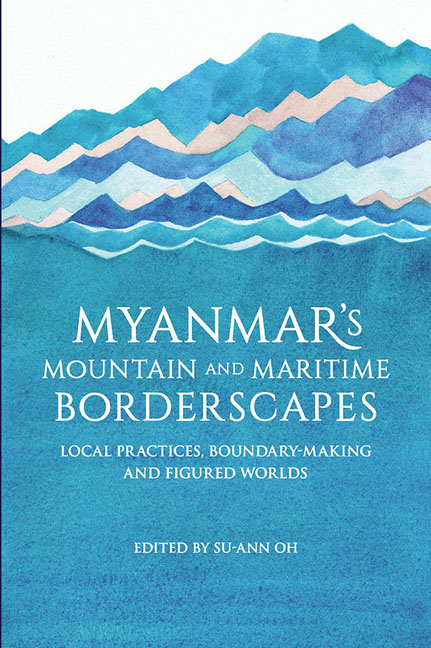Book contents
- Frontmatter
- Contents
- List of Tables
- List of Figures
- Acknowledgements
- Notes on Language, Terminology and Geographical Names
- Contributors
- Abbreviations
- 1 Introduction
- I Overview of Myanmar's Mountain and Maritime Borderscapes
- II Territorial Claims and Imagined Boundaries
- III Social Organization and Border Economies
- IV Mobile Practices and Moving Borders
- V Identity Construction and the Politics of Belonging
- 11 “I Want to Stay Forever in You”
- 12 Life along the Naf Border: Identity Politics of the Rohingya Refugees in Bangladesh
- 13 Home of the Housekeeper: Will Shan Migrants Return after a Decade of Migration?
- 14 Moving on: Spaces of Engagement in the Kayah–Mae Hong Son Borderland
- VI Institutionalized Identity and Border Practices
- Index
14 - Moving on: Spaces of Engagement in the Kayah–Mae Hong Son Borderland
from V - Identity Construction and the Politics of Belonging
Published online by Cambridge University Press: 06 June 2017
- Frontmatter
- Contents
- List of Tables
- List of Figures
- Acknowledgements
- Notes on Language, Terminology and Geographical Names
- Contributors
- Abbreviations
- 1 Introduction
- I Overview of Myanmar's Mountain and Maritime Borderscapes
- II Territorial Claims and Imagined Boundaries
- III Social Organization and Border Economies
- IV Mobile Practices and Moving Borders
- V Identity Construction and the Politics of Belonging
- 11 “I Want to Stay Forever in You”
- 12 Life along the Naf Border: Identity Politics of the Rohingya Refugees in Bangladesh
- 13 Home of the Housekeeper: Will Shan Migrants Return after a Decade of Migration?
- 14 Moving on: Spaces of Engagement in the Kayah–Mae Hong Son Borderland
- VI Institutionalized Identity and Border Practices
- Index
Summary
INTRODUCTION
Geopolitically induced forced migration created a legacy of chronic human insecurity, internal displacement, and cross-border exile for tens of thousands of Karenni people for over two decades. Under military rule the country was relatively isolated, except for exploitative resource economy investments by China, Thailand and other Asian neighbours. As Myanmar now goes through fundamental political economic reform processes, many profound changes are affecting the political and human landscape of ethnic border zones.
We focus on Karenni displaced persons, particularly cross-border refugee populations, who face dilemmas such as whether or not to return to lands many of them were coerced into leaving, and which even in relative peacetime have precarious human security. Simultaneously, Myanmar's contested borderlands are experiencing relative absence of armed conflict for the first time in decades, and they are being opened to inward investment, intensified resource exploitation and a complex array of new emerging relations with actors and agencies operating inside Myanmar.
Political and economic changes in the borderlands bring in forms of land and resource dispossession, exclusion/inclusion, and inequality in terms of ownership, access and property rights. We argue that agencies concerned with developmental change and human security need to seriously take into account legacies of past (and current) geopolitical conflicts whilst taking a critical look at the nature and purposes underlying political economic change. Understanding the cumulative legacy of past conflicts is vital to any current examination of the changing political economic landscape. Equally necessary is the analysis of Myanmar becoming a legitimized space for global investment, which generates many projects, but also carries dilemmas of highly differentiated economic benefits that do not necessarily alleviate poverty in former conflict zones.
The chapter focuses primarily upon key transformations in the lives of ordinary Karenni refugees living in Mae Hong Son, Thailand, and reflects upon the major transformations affecting the Kayah (Myanmar) — Mae Hong Son (Thailand) borderland, particularly in relation to issues of human and livelihood security for residents and returnees. It maps lives across the border through ethnographic and everyday geographies relating to past and current contexts.
Previously, the geopolitics of national reconsolidation generated ceasefires between the military junta and various armed ethnic groups in the borderlands, whilst conflict continued with non-ceasefire groups, such as the Karenni National Progressive Party (KNPP). However, a new era of national reconciliation has opened up.
- Type
- Chapter
- Information
- Myanmar's Mountain and Maritime BorderscapesLocal Practices, Boundary-Making and Figured Worlds, pp. 323 - 350Publisher: ISEAS–Yusof Ishak InstitutePrint publication year: 2016

